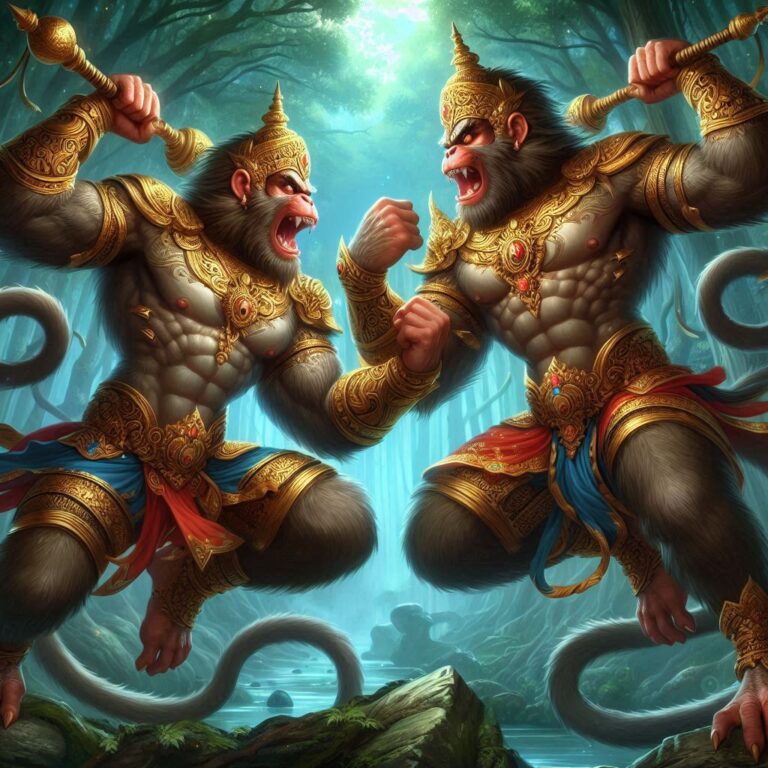The Divine Birth of Rama
The birth of Lord Rama, the seventh avatar of Vishnu, is one of the most celebrated events in Hindu tradition. It marks the beginning of the epic journey that unfolds in the Ramayan, where Rama, the embodiment of righteousness, takes on the formidable task of vanquishing evil and restoring Dharma. This article delves into the prophecy that foretold Rama’s divine birth, the circumstances that led to it, and its profound significance.

Ayodhya and King Dasharatha
Ayodhya, the capital of the Kosala kingdom, was a city of immense prosperity and spiritual fervor during King Dasharatha‘s reign. Dasharatha was a just and powerful ruler, beloved by his people. However, despite his success as a king, he was deeply troubled by the absence of an heir to continue his lineage.
Dasharatha‘s longing for a son was not just a personal desire but also a matter of great importance for the kingdom. The lack of an heir threatened the future stability of Ayodhya, and this weighed heavily on the king’s heart.
The Prophecy
The birth of Rama was predestined by divine forces. Lord Vishnu, who had vowed to protect Dharma whenever it was threatened, decided to incarnate as a human to defeat the demon king Ravana, whose tyranny had reached its zenith. Lord Brahma, recognizing the need for divine intervention, granted boons to the Devas, enabling them to take part in the birth of Vishnu’s avatar.
Narada Muni, the celestial sage, played a significant role in conveying the prophecy. He foretold that the Supreme Being would take birth in the Raghu dynasty, bringing relief to the suffering world.
Dasharatha’s Despair and the Putrakameshti Yajna
Dasharatha’s sorrow over his childlessness was profound. He consulted with his royal priest, Sage Vashishta, who advised him to perform the Putrakameshti Yajna, a sacred ritual to invoke the blessings of the gods for progeny. The king, with great hope, undertook the yajna with utmost devotion.
The Divine Intervention
During the yajna, the fire god Agni appeared, bearing a bowl of sacred kheer (pudding). He instructed Dasharatha to distribute the kheer among his three queens, Kausalya, Kaikeyi, and Sumitra. The divine intervention was a clear sign that the prayers of the king had been answered.
The Birth of Rama and His Brothers
In due course, the queens gave birth to four sons. Kausalya bore Rama, Kaikeyi bore Bharata, and Sumitra gave birth to the twins Lakshmana and Shatrughna. Rama’s birth, in particular, was marked by extraordinary auspiciousness. Astrologers observed that the planets aligned perfectly, indicating the arrival of a divine being.
The Celebration in Ayodhya
Ayodhya was enraptured with joy at the birth of the princes. The royal palace was filled with festivities, and the entire kingdom celebrated the arrival of the heirs to the throne. Sage Vashishta performed the naming ceremony, where the firstborn was named Rama, signifying “one who brings joy.”
The Divine Nature of Rama
Rama was not just a prince; he was the incarnation of Lord Vishnu himself. His life was destined to be a testament to the principles of Dharma. Unlike other children, Rama exhibited qualities of divinity from a young age, embodying the virtues of truth, compassion, and righteousness.
दोहा:
“श्रीराम चंद्र कृपालु भज मन हरण भव भय दारुणं।
नव कंज लोचन कंज मुख कर कंज पद कंजारुणम्॥”
**Shri Ram Chandra Kripalu Bhaj Man Haran Bhav Bhay Daarunam |
Nav Kanj Lochan Kanj Mukha Kar Kanj Pad Kanjarunam ||
Translation: “O mind, revere Lord Ramachandra, the compassionate one, who removes the dreadful fear of worldly existence. His eyes are like lotus petals, his face like a lotus, his hands like lotuses, and his feet are also red like lotuses.”**
Rama’s Childhood and Divine Qualities
From a young age, Rama displayed characteristics that set him apart. His wisdom and understanding were far beyond his years, and he shared a deep bond with his brothers. Under the guidance of Sage Vashishta, Rama’s education and spiritual growth flourished, preparing him for the great responsibilities that lay ahead.
The Symbolism of Rama’s Birth
Rama’s birth is symbolic of hope and righteousness in the face of adversity. As the ideal son, his life exemplified the virtues of obedience, sacrifice, and devotion. His birth also represents the victory of good over evil, as he was destined to destroy the demon king Ravana.
The Role of Kausalya and the Other Queens
Kausalya, Rama’s mother, played a significant role in his upbringing. Her devotion and wisdom were instrumental in shaping Rama’s character. The relationships between the queens were marked by mutual respect and love, reflecting the harmony that prevailed in the royal household.
Rama’s Birth in Cultural and Religious Celebrations
The birth of Rama is celebrated with great fervor during Rama Navami, a festival that honors his arrival in the world. This day is marked by fasting, prayers, and recitations of the Ramayan. The influence of Rama’s birth extends to art, literature, and devotional practices across India.
Rama as the Ideal Hero
Rama is revered as the epitome of the ideal hero in Hindu tradition. His life is a source of inspiration, teaching the values of duty, honor, and selflessness. The lessons from Rama’s life continue to resonate, influencing the moral fabric of society.
Conclusion
The divine birth of Rama is a pivotal moment in the Ramayan and in Hindu tradition. It signifies the arrival of a savior destined to restore balance and righteousness in the world. Rama’s legacy, rooted in his birth and life, continues to inspire millions, reminding us of the eternal battle between good and evil and the ultimate triumph of Dharma.
FAQs
1. What was the significance of the prophecy related to Rama’s birth?
- The prophecy foretold the birth of Lord Vishnu as a human to defeat Ravana and restore Dharma. It highlighted the divine plan to protect the world and emphasized the importance of Rama’s role in the cosmic order. The prophecy was central to the narrative of the Ramayan, as it set the stage for the divine intervention needed to defeat the forces of evil.
2. Why was King Dasharatha so desperate for an heir?
- King Dasharatha’s desperation for an heir stemmed from both personal and political concerns. Without an heir, the future of the Kosala kingdom was uncertain, and the stability of Ayodhya was at risk. Additionally, the king longed for a son to continue his lineage and fulfill his duties as a father and ruler.
3. What is the significance of the Putrakameshti Yajna?
- The Putrakameshti Yajna was a sacred ritual performed by King Dasharatha to seek the blessings of the gods for progeny. This yajna was instrumental in bringing about the birth of Rama and his brothers, as it invoked divine intervention and fulfilled the prophecy. The ritual symbolizes the importance of devotion, faith, and the power of prayer in Hindu tradition.
4. How is Rama’s birth celebrated today?
- Rama’s birth is celebrated with great reverence during Rama Navami, a major Hindu festival. Devotees observe fasting, perform pujas, recite the Ramayan, and participate in processions. The festival is a time of joy and reflection, honoring the virtues and legacy of Lord Rama.
5. What lessons can be drawn from the birth and life of Rama?
- The birth and life of Rama offer numerous lessons, including the importance of righteousness (Dharma), the value of duty and sacrifice, and the power of devotion. Rama’s life serves as a guide for living a virtuous life, emphasizing the triumph of good over evil and the significance of upholding moral principles.






